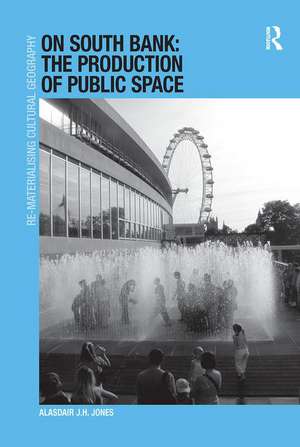On South Bank: The Production of Public Space
Autor Alasdair J.H. Jonesen Limba Engleză Paperback – 9 sep 2016
| Toate formatele și edițiile | Preț | Express |
|---|---|---|
| Paperback (1) | 469.34 lei 6-8 săpt. | |
| Taylor & Francis – 9 sep 2016 | 469.34 lei 6-8 săpt. | |
| Hardback (1) | 1059.93 lei 6-8 săpt. | |
| Taylor & Francis – 28 iun 2014 | 1059.93 lei 6-8 săpt. |
Preț: 469.34 lei
Nou
Puncte Express: 704
Preț estimativ în valută:
89.82€ • 97.53$ • 75.45£
89.82€ • 97.53$ • 75.45£
Carte tipărită la comandă
Livrare economică 22 aprilie-06 mai
Preluare comenzi: 021 569.72.76
Specificații
ISBN-13: 9781138246218
ISBN-10: 1138246212
Pagini: 304
Dimensiuni: 156 x 234 mm
Greutate: 0.45 kg
Ediția:1
Editura: Taylor & Francis
Colecția Routledge
Locul publicării:Oxford, United Kingdom
ISBN-10: 1138246212
Pagini: 304
Dimensiuni: 156 x 234 mm
Greutate: 0.45 kg
Ediția:1
Editura: Taylor & Francis
Colecția Routledge
Locul publicării:Oxford, United Kingdom
Notă biografică
Alasdair Jones is Lecturer in Qualitative Research Methodology at the Department of Methodology, London School of Economics & Political Science, UK.
Recenzii
’In this detailed exploration of London's South Bank, Jones provides a timely exploration of what is a truly public or social space. Navigating issues of design, politics, ethnography, finance, planning and performance, On South Bank is a thoughtful and timely contribution to our understanding of both the South Bank itself and public spaces in general.’ Iain Borden, Bartlett School of Architecture, University College London, UK 'On South Bank: The Production of Public Space, by Alasdair J. H. Jones, is a compelling read, which explores the tensions between the coming of public space as a design subject and its concomital erosion, transfiguration and closing down by forces more powerful than its everyday users and architects ... As both an academic and ordinary member of the public, I would recommend On South Bank to a wide and diverse audience'. Journal of Urbanism
'Alasdair Jones presents us with an ethnographical account of street-level socio-spatial relations on London’s South Bank. Here, the mixture of public and privately owned spaces such as the Southbank Centre, along with their distinct groups of users and an active transformation during the course of the author’s investigation, make for a set of power relations worthy of empirical study…As is often the case with good research, the book is undoubtedly a labour of love and was influenced by prior personal connections to the site of the study, as the author himself used to skate in the undercroft. However, far from giving only a skewed narrative of skating, the book provides a vivid account of the South Bank, focussing on the complexities of privately owned space that is not only publicly accessible, but designated to serve the public.' The London Journal
'Alasdair Jones presents us with an ethnographical account of street-level socio-spatial relations on London’s South Bank. Here, the mixture of public and privately owned spaces such as the Southbank Centre, along with their distinct groups of users and an active transformation during the course of the author’s investigation, make for a set of power relations worthy of empirical study…As is often the case with good research, the book is undoubtedly a labour of love and was influenced by prior personal connections to the site of the study, as the author himself used to skate in the undercroft. However, far from giving only a skewed narrative of skating, the book provides a vivid account of the South Bank, focussing on the complexities of privately owned space that is not only publicly accessible, but designated to serve the public.' The London Journal
Cuprins
1: Introduction; 2: Public Space as a Research Setting; 3: Boundary Effects; 4: South Bank as Theme Park? Public Space and the Practical Accommodation of Disorder; 5: Play and Public Space; 6: ‘The Stamp of the Definitive' 1; 7: Conclusion
Descriere
Through an in-depth ethnographic examination of London's 'South Bank', this book explores the value widely presupposed on urban public space. Based on subjective accounts of the value of public space, as well as observations of how the South Bank is used and 'practised' on a daily basis, it argues that this value is not so much inherent to physical public space itself as it is derived through the everyday use and production of that space. Public space is valued not only for its essential material characteristics but also for the productive potential that these characteristics, if properly managed, afford on a daily basis.
